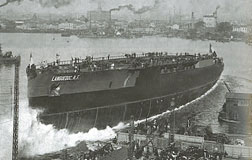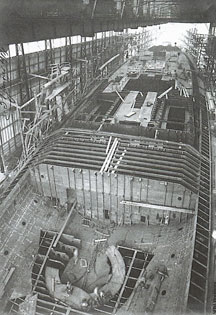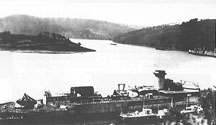| The
Normandie-Class Battleships
By Mike Bennighof, Ph.D.
January 2013
Britain’s launch of the battleship
Dreadnought touched off an international
arms race, as other European powers, Germany
in particular, sought to build large numbers
of the powerful new type of warship. For the
first several years of this deadly competition,
the battleship designs followed certain parameters.
They carried a main armament of 10 or 12 12-inch
guns, and a speed of 20 to 21 knots. Britain,
Germany, Austria-Hungary, Russia, Italy and
France all laid down ships of widely varying
appearance but with these same characteristics.
But in 1909, the British introduced the
first “super dreadnoughts” armed
with 13.5-inch guns. The Orion class
was laid down in 1910 and entered service
in 1912. The Japanese armed their battle cruiser
Kongo a year later with a very similar
14-inch gun, France went to a 13.4-inch gun
for their Bretagne class laid down
in 1912, and Austria-Hungary went to a 13.8-inch
gun for the Ersatz Monarch class the
navy hoped to begin in 1912.
| 
Battleship Languedoc is launched,
May 1915.]
|
The Orion class started a race in size
and power, as well as total number, of dreadnoughts.
Warships became ever larger and new designs
with 15-inch and even 16-inch guns appeared
on drawing boards. Britain and Germany built
battleships with 15-inch guns, while Italy started
four. Similar ships never left Russian and Austrian
drafting tables. But in France, designers strayed
from this pattern.
Where other designers went for heavier guns,
the French designed ships to carry more of
them. The battleships planned for the 1913
fiscal year could only be slightly larger
than Bretagne, because of the limitations
of French docks and other facilities. Huge
ships like the British Queen Elizabeth
or Italian Caracciolo were therefore
out of the question. The navy’s Technical
Committee presented two alternative designs:
one with sixteen 12-inch guns in four quadruple
turrets, with a pair of superfiring turrets
fore and aft, the other with a dozen 13.4-inch
guns, with a twin turret superfiring above
a quadruple turret both fore and aft. They
also mentioned, but did not sketch, an alternative
arrangement with three quadruple turrets at
the same deck level, one of them being sited
amidships.
The quadruple turret had been developed
by the Saint-Chamond industrial works in 1911.
It consisted of two pairs of guns revolving
on a single pivot, with an armored screen
dividing two gun rooms. It amounted to two
separate turrets combined into one, and received
rave reviews from the Technical Committee.
It would allow more heavy guns to be mounted
on the same displacement, as the two “turrets”
could share the same heavily-armored barbettes
and shell rooms.
| 
Flandre under construction,
January 1914.
|
Bretagne had five twin turrets, two each
fore and aft and one sited amidships. This last
turret position greatly annoyed the Technical
Committee, which had not been consulted on the
Bretagne design and whose engineers seem
to have been venting some bureaucratic frustration.
An amidships turret, they argued, had by its
very nature a limited field of fire and the
guns would damage nearby equipment when fired.
The two alternative designs eliminated this
feature, which other navies had also abandoned
for their new ships.
But the Navy’s general staff seized
on the brief technical note mentioning a 12-gun
ship with an amidships turret. They also noted
that use of an amidships turret helped distribute
the great weight of a battleship’s main
armament more evenly on the hull. They ordered
two designs prepared: a ship very similar
to Bretagne, with ten 13.4-inch guns
in five twin turrets, and one with 12 such
guns in three quadruple turrets. If the quadruple
turret could pass muster with the Navy’s
engineers, this design would be chosen.
The quadruple turret sailed through its
tests, and in July 1912 the Navy began issuing
contracts. Four new battleships, to be known
as the Normandie class, would be laid
down: two (Normandie and Languedoc)
in private yards in April 1913, and two
more (Gascogne and Flandre) in
naval dockayrds in October. To provide two
divisions of four ships each (counting the
three Provence-class ships), a fifth
battleship, initially named Vendée
but later changed to Béarn,
was ordered in December.
| 
Flandre awaits a decision.
|
All five ships were under construction when
the First World War erupted in August 1914.
As in other countries, the French high command
expected a short war and did not exempt skilled
shipyard workers from conscription. Over the
next 10 months four of the battleships were
launched to clear the slipways for more urgent
work, with the hulls laid up nearby. Only Béarn,
not advanced enough to launch, remained
on her slip. The navy gave strict orders that
no material gathered for the battleships was
to be diverted for other uses, but in all
five shipyards, managers appear to have violated
this ruling fairly liberally and both steel
and equipment purchased for the dreadnoughts
went to build and repair the badly-needed
escort craft and transport ships.
The war ground on while the battleships
slowly rusted. In December 1917 the British
Admiralty approached the Marine Nationale
with an offer to buy the four more advanced
ships, thinking it would be more cost-effective
to complete these than to lay down new battleships.
The British had already expressed apprehension
over American determination to continue building
battleships that were clearly not needed or
intended to fight the Germans. The French
for their part were willing to sell, but warned
the British that the radically different design
of the ships would make them nearly impossible
to recast to a more traditional form. After
brief study the British accepted the French
assessment, and with French industry clearly
unable to complete the ships, withdrew the
purchase offer.

Less than two weeks after the 11 November
1918 Armistice, the French began to contemplate
restarting construction. The Navy now wanted
better protection and a speed increase to
28 knots. This would require a much larger
ship, and the Technical Committee’s
answer rather curtly pointed out that no improvements
had been made to France’s drydocks in
the intervening six years. The admirals accepted
completion of the four advanced ships with
improved anti-torpedo protection, much thicker
deck armor and better elevation for the main
guns. The underwater torpedo tubes would be
removed and replaced by six trainable mounts
above the waterline.
The Germans had overrun the factory near
Lille where Gascogne’s turrets had been
under construction. The Germans carried them
off and used the guns themselves on railway
mounts; no one seemed able to find the actual
turrets. The Navy ordered the turrets intended
for Béarn transferred to Gascogne,
and laid out three alternatives for Béarn:
conversion to an aircraft carrier, completion
as a standard Normandie-class battleship
once new turrets had been fabricated, or completion
with three twin turrets for a new 400mm (15.8-inch)
gun then under development. The admirals appear
to have preferred to experiment with a carrier,
which would become the hull’s eventual
use.
By September 1919, work had not resumed and
the French government had finally come to
grips with economic reality. French industry
and society had been shattered by the Great
War, and there would be no huge German cash
indemnity forthcoming, at least not anytime
soon. When the Italian government gave assurances
that, under equal financial pressures, it
would complete at most one of their big Caracciolo
class battleships abandoned in 1916, if
that, the French abandoned hope of finishing
the ships. In January 1920, “Plan 171”
for new construction did not include the Normandie
class, execpt for the conversion of Béarn
into an aircraft carrier. Unofficial plans
floated around for a few more years, but the
1922 Naval Law formally cancelled all of them.
Though sometimes cited as victims of the Washington
Naval Treaty, this is not so: The French had
already decided to scrap the Normandie
class when the negotiations opened, but
skillfully used the “sacrifice”
of the four useless hulls to win many of the
points they desired in the treaty.
Great
War at Sea: U.S. Navy Plan Gold includes
all five ships in battleship guise,
plus Béarn as an aircraft
carrier.
Click here to order Plan
Gold now. |


